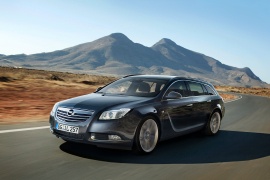OPEL Insignia Sports Tourer Models/Series Timeline, Specifications & Photos
First production year: 2009
Engines: Gasoline, Diesel, Natural gas, Ethanol
Body style: Wagon (station wagon, estate, combi, touring)
Opel unveiled the second generation of the Insignia Sports Tourer in 2017 at the Belgrade Motor Fair Trade, an unusual location to show its vehicle.
The German carmaker was ready to storm the dealers' network with the Insignia, and the Sports Tourer was one of the most important versions in the lineup. There were not too many station wagon vehicles left on the market, and Opel tried to convince its customers that the car was more than just an Insignia with a bigger trunk.
The Insignia Sports Tourer showed the same front fascia as its sedan version, with a broad grille that supported a pair of wings and the round badge. At the lower side of the bumper, the carmaker installed chromed accents on top of the fog lamps and a lower trapezoidal grille under the license plate. On the sides, the aerodynamically profiled sills and the sculptured line that crossed the door onto the quarter panels enhanced the car's dynamic view. Its raked forward tailgate and the roof-spoiler showed an appetite for long journeys and sporty driving.
Inside, the high-bolstered seats promised good lateral support during high cornering speeds, while the "zero-gravity" design tried to keep the occupants rested even after long hours. Its split-folding rear bench transformed the trunk into a cavernous storage area, among the mid-size segment's biggest.
Opel offered the Insignia Sports Tourer a choice of three gasoline and one turbo-diesel engines under the hood.
Opel introduced the Insignia in 2008 as a sedan and a hatchback, while the station wagon version followed in the next year.
GM's German brand was in deep financial troubles. The global financial crisis and the workers strikes made the situation even worse, and the American carmaker considered selling the brand, but it changed its mind at the last minute. It used the same platform as its sedan and hatchback siblings and the Chevrolet Malibu in the U.S., but with a different back.
The car kept the same front fascia with its unique boomerang-shaped daytime running lights inside the headlights. From its sides, the more extended, slightly sloped roof made the vehicle looked sportier. The car was longer than its siblings due to the extended rear overhang. In the back, the liftgate featured a particular detail. When it was opened, an additional set of lights mounted on the D-pillars remained in place so the car could have been seen from a distance, even in a pitch-black night, with the liftgate opened.
Inside, the Insignia gathered more innovations. Its front seat seatbacks were thicker by 2 cm (0.8"), offering softer support for their occupants. The rear knee room was bigger by 3 cm (1.2") than the outgoing Vectra. A new infotainment generation included a seven-inch color monitor with a 3-D map view, digital travel guide, and improved scroll and zoom functions. In the back, the split-folding bench increased the trunk size from 540 liters (19 cu-ft) to 1,530 liters (54 cu-ft).
Opel installed an extensive engine range on the Insignia. The base version featured a 1.4-liter turbocharged unit, while a 2.8-liter turbocharged V-6 powered the most potent version. The Insignia Sports Tourer was available with either front or all-wheel-drive.
OPEL Insignia Sports Tourer 1.4L Turbo Ecoflex 6MT (140 HP)
OPEL Insignia Sports Tourer 1.6L ECOTEC 6MT (115 HP)
OPEL Insignia Sports Tourer 1.6l Turbo ECOTEC 6MT (180 HP)
OPEL Insignia Sports Tourer 1.8L ECOTEC 6MT (140 HP)
OPEL Insignia Sports Tourer 2.0L Turbo 6AT AWD (220 HP)
OPEL Insignia Sports Tourer 2.0L Turbo 6MT AWD (220 HP)
OPEL Insignia Sports Tourer 2.0L Turbo ECOTEC 6AT AWD (250 HP)
OPEL Insignia Sports Tourer 2.0L Turbo ECOTEC 6MT AWD (250 HP)
OPEL Insignia Sports Tourer 2.0L CDTI 6AT (130 HP)
OPEL Insignia Sports Tourer 2.0L CDTI 6AT (160 HP)
OPEL Insignia Sports Tourer 2.0L CDTI 6MT (110 HP)
OPEL Insignia Sports Tourer 2.0L CDTI 6MT (130 HP)
OPEL Insignia Sports Tourer 2.0L CDTI 6MT (160 HP)

